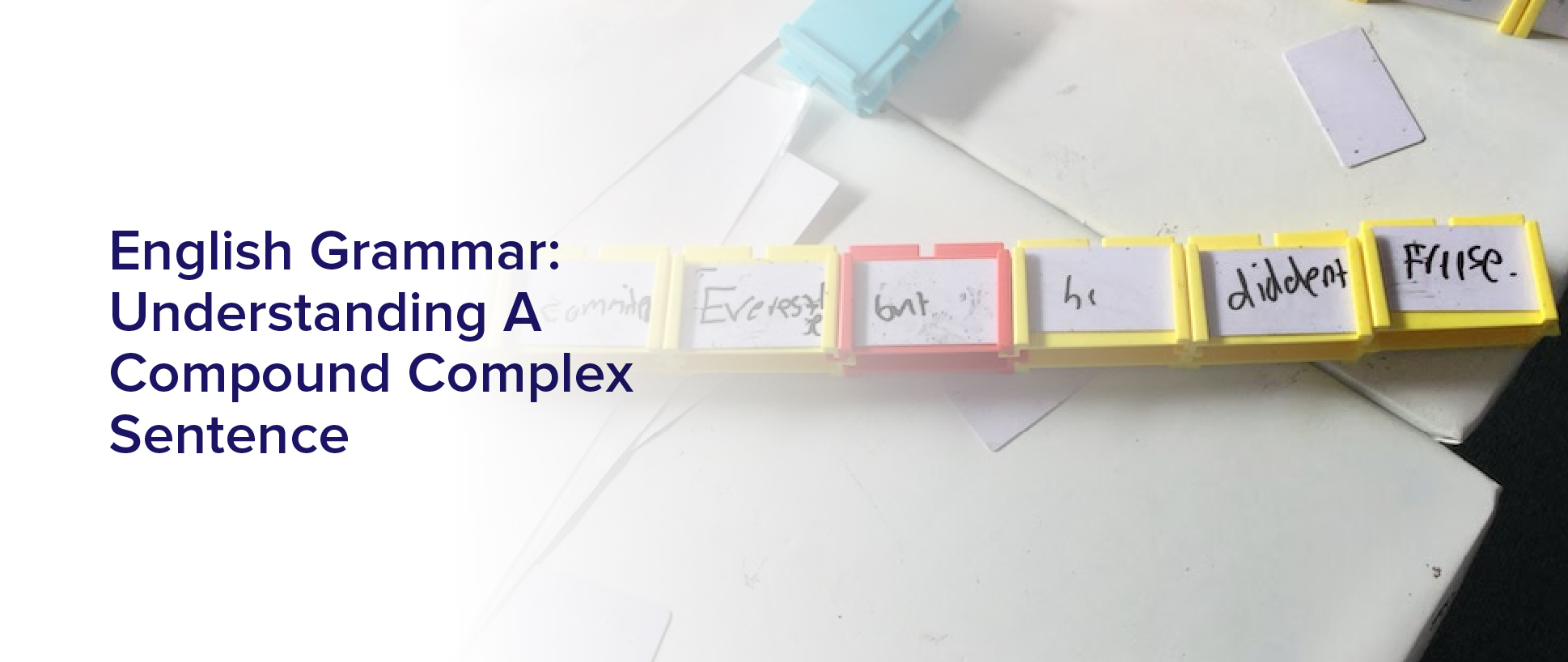If you’re looking to improve your writing and communication skills, understanding English grammar is a must.
One aspect of grammar that often trips people up is the compound complex sentence. Don’t worry, though, with a little guidance you’ll be able to master this sentence structure in no time!
A compound complex sentence is a sentence that contains at least two independent clauses and one or more dependent clauses. These clauses are combined in a way that allows for complex ideas to be expressed in a single sentence.
Understanding how to identify and properly use these clauses is key to crafting effective sentences that clearly convey your message.
So, let’s dive in and take a closer look at this sentence structure.
What is a Compound Complex Sentence?
Do you know what a compound complex sentence is? It’s when you combine two or more independent clauses and at least one dependent clause. Don’t worry, it may sound complicated, but it’s actually a great way to add variety and depth to your writing.
Let me give you an example of a compound complex sentence:
‘She went to the store, but she forgot her wallet, which she realized when she tried to pay for her groceries.’
In this sentence, ‘She went to the store’ and ‘She forgot her wallet’ are both independent clauses joined by the conjunction ‘but.’ The dependent clause, ‘which she realized when she tried to pay for her groceries,’ adds more information to the second independent clause.
See how the sentence becomes more interesting and dynamic with the use of a compound complex sentence?
Understanding Independent Clauses
You’ll feel confident when you can easily identify the parts of a sentence that can stand alone as their own thoughts. These parts are called independent clauses, and they are the building blocks of compound complex sentences.
An independent clause is a group of words that contains a subject and a verb and expresses a complete thought. It can stand alone as a sentence or be combined with other independent clauses to create a more complex sentence.
To better understand independent clauses, let’s look at some examples. “I went to the store”is an independent clause because it contains a subject (I) and a verb (went) and expresses a complete thought. “She loves to read”is another example of an independent clause.
Both of these sentences can stand alone as their own thoughts, but they can also be combined with other independent clauses to create compound complex sentences. By recognizing and understanding independent clauses, you’ll be able to identify the different parts of a compound complex sentence and analyze its structure.
Identifying Dependent Clauses
Identifying dependent clauses can enhance your grasp of sentence structure and writing style. Dependent clauses, also known as subordinate clauses, depend on independent clauses to make sense. They can’t stand alone as a complete sentence and usually begin with a subordinating conjunction such as ‘although,’ ‘because,’ ‘since,’ ‘when,’ or ‘while.’
For example, ‘Although I love pizza, I’m trying to eat healthier.’ The dependent clause ‘Although I love pizza’ can’t stand alone as a sentence; it needs the independent clause ‘I’m trying to eat healthier’ to make sense.
Dependent clauses can add complexity and depth to your writing. They can provide additional information, introduce contrast or cause-and-effect relationships, and show the relationship between ideas. Understanding how to use dependent clauses can help you create more complex sentences and convey your ideas more effectively.
However, it’s important to use them correctly to avoid creating run-on sentences or confusing your readers. Practice identifying dependent clauses in your writing and see how they contribute to the overall structure and style of your sentences.
Combining Clauses to Create a Compound Complex Sentence
By combining clauses with the right conjunctions, you can create compound complex sentences that add depth and complexity to your writing. These sentences allow you to convey more information in a single sentence, making your writing more concise and effective.
To create a compound complex sentence, you need to have at least two independent clauses and one or more dependent clauses. These clauses can be combined using coordinating conjunctions like ‘and,’ ‘but,’ or ‘or,’ as well as subordinating conjunctions like ‘although,’ ‘because,’ or ‘while.’ By using these conjunctions, you can create sentences that show the relationship between different ideas and events, making your writing more engaging and interesting to read.
Examples of Effective Use of Compound Complex Sentences
Imagine how much more captivating your writing could be if you could convey intricate concepts and ideas with just one sentence, using the right conjunctions and combining multiple clauses. A compound complex sentence is the perfect tool for this.
It’s a sentence composed of at least two independent clauses and one or more dependent clauses, all connected by conjunctions like ‘and,’ ‘but,’ ‘or,’ or ‘although.’
The beauty of a compound complex sentence lies in its ability to convey a lot of information in one sentence while still maintaining clarity and coherence.
One example of an effective use of a compound complex sentence is: ‘Although she was tired, she stayed up late to finish her work, and she was rewarded the next day with a promotion.’
This sentence contains two independent clauses, ‘she stayed up late to finish her work,’ and ‘she was rewarded the next day with a promotion,’ connected by the conjunction ‘and.’ It also contains a dependent clause, ‘Although she was tired,’ which adds context to the sentence.
By using a compound complex sentence in this way, the writer can communicate the cause and effect relationship between the two independent clauses while still maintaining a sense of flow and coherence in the sentence.
Common Errors to Avoid
Don’t let small mistakes ruin your writing flow and comprehension – avoid these all too common errors!
One of the most common mistakes in writing compound complex sentences is forgetting to include coordinating conjunctions like ‘and,’ ‘but,’ and ‘or’ to connect two independent clauses. Without these conjunctions, the sentence becomes a run-on, making it hard for the reader to understand the intended message. For example, “She went to the store she bought some milk”instead of “She went to the store, and she bought some milk.”
Another mistake to avoid is using too many dependent clauses, making the sentence too long and complicated. Readers may lose track of the main subject and action, leading to confusion. It’s important to balance the number of independent and dependent clauses to ensure clarity and understanding.
Additionally, make sure to use the correct punctuation marks, such as commas, semicolons, and colons, to indicate the relationship between the clauses.
By avoiding these common errors, you can effectively communicate your message through well-structured compound complex sentences.
Tips for Improving Your Writing and Communication Skills
Now that you know what common errors to avoid when writing a compound complex sentence, it’s time to focus on improving your writing and communication skills. Improving your writing skills can help you not only in your academic or professional life but also in your personal life.
Good writing skills can help you convey your message clearly and effectively, which is essential in any communication.
One of the first tips for improving your writing skills is to read more. Reading can help you expand your vocabulary, understand different styles of writing, and learn how to structure your sentences.
Another tip is to practice writing regularly. Set aside some time each day to write, whether it’s a journal entry, a blog post, or even an email. This will help you develop your writing skills and make them a habit.
By improving your writing skills, you’ll be able to communicate your thoughts and ideas more clearly and confidently.
Frequently Asked Questions
What is the history of compound complex sentences in the English language?
Compound complex sentences have been a part of the English language for centuries. They’re a natural way of expressing complex ideas and thoughts in a single sentence.
English has evolved over time, and so has the use of compound complex sentences. In fact, some of the earliest English literature contains examples of compound complex sentences.
As the language has developed, so too has the complexity and variety of the sentences used. Today, compound complex sentences are commonly used in both spoken and written English, and are an essential component of effective communication.
Whether you’re writing an essay, giving a presentation, or simply having a conversation, understanding and using compound complex sentences is crucial for conveying your message clearly and effectively.
Can a compound complex sentence have more than two independent clauses?
You may be wondering if a compound complex sentence can have more than two independent clauses. The answer is yes, it can.
A compound complex sentence is just a sentence that has two or more independent clauses and at least one dependent clause. The number of independent clauses in a compound complex sentence can vary, as long as there is at least one dependent clause that connects them.
So, if you want to write a sentence with three or more independent clauses, you can do so, as long as you use a dependent clause to connect them all together. Just remember to use proper punctuation and conjunctions to make sure your sentence is clear and easy to understand.
How does the use of compound complex sentences affect the tone of a piece of writing?
When you use compound complex sentences in your writing, it can have a significant impact on the tone you convey. By combining multiple independent clauses and dependent clauses, you can create a more sophisticated and complex sentence structure that can make your writing feel more academic or formal.
This can be especially useful when you want to convey a sense of authority or expertise on a topic. However, it’s important to be careful not to overuse compound complex sentences, as it can make your writing feel convoluted or difficult to understand.
Ultimately, the tone you create with your writing depends on a variety of factors, including your word choice, sentence structure, and overall writing style.
What are some common pitfalls to avoid when attempting to create a compound complex sentence?
When attempting to create a compound complex sentence, there are some common pitfalls to avoid.
First and foremost, avoid making the sentence too long and convoluted, as this can lead to confusion and a loss of clarity.
Additionally, be sure to use proper punctuation, including commas and conjunctions, to clearly indicate the relationships between the clauses.
It’s also important to ensure that the sentence is grammatically correct and that all verb tenses and subject-verb agreements are consistent throughout.
Finally, be careful not to use overly complex language or syntax that may be difficult for readers to understand.
By following these guidelines, you can create a clear and effective compound complex sentence without falling into these common pitfalls.
How can the use of compound complex sentences improve one’s ability to communicate effectively?
Using compound complex sentences can greatly enhance your ability to communicate effectively. By combining multiple ideas into a single sentence, you can convey complex thoughts and concepts in a concise and efficient manner.
This can be especially useful in professional or academic writing, where clarity and precision are key. Additionally, mastering the use of compound complex sentences can demonstrate a high level of writing proficiency, which can be impressive to employers and peers alike.
However, it’s important to avoid common pitfalls, such as using too many clauses or making the sentence too convoluted. With practice and careful attention to structure, you can leverage the power of compound complex sentences to elevate your writing to the next level.
Conclusion
So, you’ve learned about compound complex sentences and how to identify and create them. But why does it matter?
Effective communication is essential in both written and verbal forms, and using a variety of sentence structures can make your writing more engaging and easier to understand. By incorporating compound complex sentences, you can convey complex ideas and relationships between clauses in a clear and concise manner. However, it’s important to avoid common errors such as run-on sentences and misplaced modifiers.
In summary, mastering the use of compound complex sentences can greatly enhance your writing and communication skills. Keep practicing and incorporating them into your writing, and you’ll be sure to impress your audience with your clear and effective communication.


